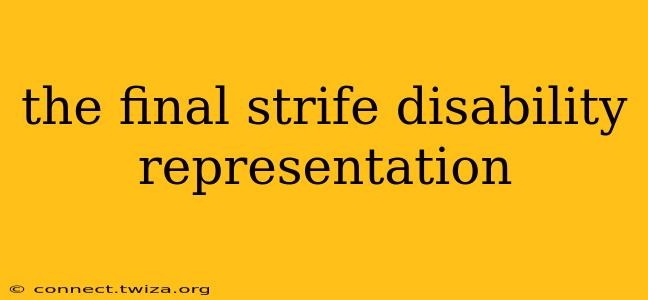The portrayal of disability in media has a long and complex history, often marked by stereotypes, tokenism, and a lack of authentic representation. While progress has been made, significant challenges remain in achieving truly inclusive and nuanced depictions of disabled characters. This exploration delves into the current state of disability representation, examining its shortcomings and celebrating the strides forward, while focusing on what we can do to improve the final strife for accurate and empathetic portrayal.
What are the common stereotypes of disabled people in media?
Common stereotypes often perpetuate harmful misconceptions. Disabled characters are frequently depicted as:
- Inspirational Portrayals: The "overcoming adversity" narrative, while sometimes relatable, can overshadow the individual's full humanity and reduce them to their disability. The focus shifts from their everyday life to their struggle, neglecting other aspects of their identity.
- Villainous or Comic Relief: Disabled characters are sometimes used as antagonists to create a sense of menace or as comedic sidekicks to provide humor based on their disability. This reinforces negative associations and trivializes lived experiences.
- The Burden: Stories might center on the challenges faced by the caregivers of a disabled person, framing the disabled individual as a source of stress or hardship rather than a person with agency and their own aspirations.
- The Magical Cure: A plot often revolves around a miraculous cure or technological advancement "fixing" the disability, reinforcing the societal belief that disability is something to be eradicated rather than embraced as a form of human diversity.
How is disability representation improving?
Despite the pervasive stereotypes, positive shifts are underway. We're seeing:
- Increased Visibility: More disabled actors are taking on leading and supporting roles, bringing authentic perspectives and lived experiences to their characters.
- Complex and Nuanced Characters: Writers are crafting more multi-dimensional characters who are not solely defined by their disability. Their stories are enriched by exploring their relationships, careers, hobbies, and personal struggles, separate from their disability.
- Diverse Representation: The range of disabilities portrayed is expanding to include a wider spectrum of impairments, reflecting the diversity of the disabled community.
- Disability-Led Storytelling: More projects are spearheaded by disabled creators, ensuring narratives are authentic and reflect the lived experiences of disabled people.
What are the biggest challenges in achieving better disability representation?
Challenges remain in achieving meaningful representation:
- Lack of Accessible Production: The industry often lacks the necessary infrastructure and training to make productions accessible to disabled actors and crew members.
- Tokenism: The inclusion of a single disabled character without genuine integration into the storyline often feels performative rather than meaningful.
- Focus on the Medical Model: Many depictions center on the medical aspects of disability rather than the social model, which emphasizes societal barriers and the need for inclusivity.
- Lack of Disabled Voices: The creative process often lacks involvement from disabled individuals, leading to misrepresentations and reinforcing harmful stereotypes.
Why is authentic disability representation important?
Authentic disability representation is crucial for:
- Challenging Stigma: Accurate portrayals can help to break down societal stigma and promote greater understanding and acceptance.
- Promoting Inclusion: Representing disabled people as fully-fledged individuals challenges the notion that disability makes someone "less than."
- Building Empathy: Seeing diverse experiences represented on screen fosters empathy and encourages viewers to consider the perspectives of disabled people.
- Providing Role Models: Positive representations provide crucial role models for young disabled people and demonstrate the potential for fulfilling lives.
How can we improve disability representation in the future?
Positive change requires a multifaceted approach:
- Increase Disabled Representation Behind the Camera: More disabled writers, directors, producers, and crew members are needed to ensure authentic narratives and create inclusive working environments.
- Invest in Accessibility: Production companies must invest in the resources and training necessary to ensure accessibility for all.
- Focus on Intersectionality: The experiences of disabled people are diverse and intersect with other identities such as race, gender, and sexual orientation. This intersectionality must be reflected in storytelling.
- Engage Disabled Communities: Consult and actively collaborate with disability organizations and individuals to ensure accurate and meaningful representation.
The "final strife" is not an end point, but rather an ongoing struggle for greater inclusivity and accurate representation. By acknowledging the challenges, celebrating progress, and implementing strategic changes, we can move closer to a future where disability is depicted with empathy, nuance, and authenticity.
